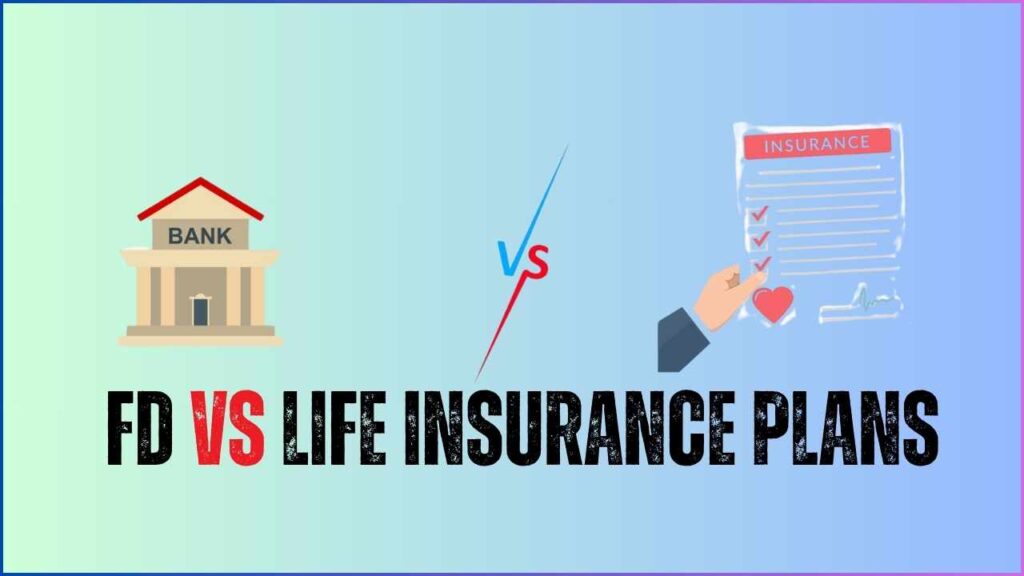India’s historical preference for savings as a financial planning pillar has retained Fixed Deposits (FDs) in the top rung of investment options for decades. At the same time, life insurance policies have solidified themselves as a vital financial instrument, providing protection and long-term savings.
On the surface, an FD and life insurance might look like comparing apples and oranges—there’s an investment vehicle and an insurance vehicle here, after all. Yet by learning what each is designed to do, its benefits and characteristics, people can make better choices based on their needs.
In this complete guide, let’s discuss FD vs Life Insurance Plans, how their characteristics, benefits, and distinctions help guide your decision on how they will work in your financial plan.

What is a Fixed Deposit (FD)?
A Fixed Deposit is a savings scheme offered by banks and financial institutions where you deposit a lump sum for a fixed tenure at a predetermined interest rate. FDs are renowned for their stability, guaranteed returns, and low risk, making them an ideal choice for conservative investors.
Key Features of FDs:
- Fixed tenure ranging from 7 days to 10 years
- Interest is calculated quarterly or annually
- Premature withdrawals are allowed but attract penalties
- Some FDs offer tax benefits under Section 80C (5-year tax-saving FDs)
- No market-linked risk—returns are guaranteed
FDs are perfect for short-term and medium-term goals, especially when liquidity and capital safety are priorities.
What is a Life Insurance Plan?
A life insurance policy is a financial contract between the insurer and the policyholder that guarantees a death benefit to the beneficiaries in case of the policyholder’s untimely death. Beyond protection, modern life insurance plans also double as investment tools, offering options like endowment plans, money-back schemes, and monthly income policies.
Key Features of Life Insurance Plans:
- Provide life coverage and financial protection
- Long-term savings with maturity benefits
- Additional bonuses and assured payouts
- Monthly income options in some plans
- Tax benefits under Section 80C and 10(10D)
- Options to customize premiums based on goals and coverage needs
Life insurance is essential for securing your family’s financial future and is a cornerstone of any responsible financial plan.
FD vs Life Insurance: A Side-by-Side Comparison
To understand which is better suited for your needs, let’s compare these two financial products based on key investment parameters:
| Criteria | Fixed Deposits (FDs) | Life Insurance Policies |
|---|---|---|
| Tenure | 7 days to 10 years | Long-term; some plans cover up to age 99 |
| Purpose | Savings and wealth accumulation | Life cover and financial protection |
| Returns | Fixed and guaranteed | Assured returns plus bonuses (depending on plan) |
| Liquidity | Premature withdrawal allowed but with penalty | Withdrawal possible after 3-year lock-in |
| Tax Benefits | 5-year tax-saving FDs offer benefits under Section 80C | Premiums eligible under 80C; Maturity tax-free under 10(10D) |
| Investment Flexibility | Minimum ₹1,000 with no upper limit | Premium varies by age, health, and policy coverage |
| Income Stream | Lump-sum payout or periodic interest | Regular income through monthly income plans or lump-sum |
| Risk Factor | Virtually risk-free | Low to moderate, depending on plan type |
| Bonus/Extra Benefit | None | No-claim bonus, additional loyalty additions, etc. |
| Market Influence | Not affected by market fluctuations | May have market exposure in ULIP-type plans |
| Ideal For | Short-term savers, low-risk appetite | Long-term planners, family protection seekers |
Returns: Safety vs Growth
Fixed Deposits offer guaranteed interest, typically ranging between 5% to 7%, depending on the tenure and the financial institution. The interest rates are locked in at the time of investment, making FDs a stable option.
Life Insurance Plans, particularly endowment or money-back policies, provide lower returns than market-linked instruments but include a death benefit, assured returns, and possible bonuses. While the returns aren’t as high as some investments, the value lies in security and long-term planning.
Withdrawal Flexibility
- FDs allow premature withdrawals, but breaking an FD early may reduce your interest earnings and could include a penalty.
- Life Insurance policies require a lock-in period of at least 3 years before you can make any withdrawal or surrender the policy. The longer you hold, the higher the maturity benefits.
Tax Benefits: FD vs Life Insurance
FDs:
- Only 5-year tax-saving FDs are eligible under Section 80C.
- Interest income is taxable and must be declared during tax filings.
Life Insurance:
- Premiums qualify under Section 80C.
- Maturity amounts are tax-free under Section 10(10D), provided certain conditions are met (e.g., sum assured is at least 10 times the premium).
Clearly, life insurance offers superior tax advantages, especially for long-term savers.
Investment Suitability: Which One Should You Choose?
Choose FD if:
- You want to park a lump sum safely for short or medium-term needs.
- Liquidity and guaranteed interest are your top priorities.
- You have a low-risk appetite.
Choose Life Insurance if:
- You seek financial security for your family in case of an emergency.
- You want to combine insurance and investment into a single plan.
- You’re planning for long-term goals like retirement or a child’s education.
FD and Life Insurance – Not an Either/Or Decision
It’s essential to understand that FDs and Life Insurance serve different financial purposes:
- FDs help you save and grow your money with low risk and are suited for emergencies or planned short-term expenses.
- Life Insurance is a protective measure—providing peace of mind, family protection, and future financial security.
If possible, integrate both into your financial strategy. Use FDs for quick liquidity and short-term goals, and rely on life insurance plans to ensure long-term safety and wealth creation.
Conclusion
While both Fixed Deposits and Life Insurance Plans play pivotal roles in financial planning, they cater to distinct objectives. FDs help develop a savings habit and offer fixed returns with liquidity. Life insurance, however, is indispensable for anyone seeking to secure their family’s future and plan for long-term financial goals.
Ultimately, the decision isn’t about choosing between FD vs Life Insurance—it’s about knowing when and how to use each to your advantage. A balanced financial portfolio should ideally include both.












